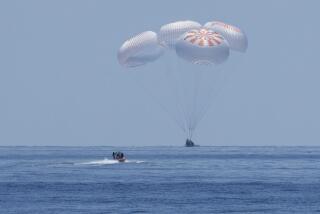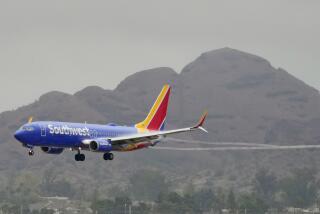JetBlue Opens Its West Coast Hub at Long Beach Airport
- Share via
It’s been called the “Southwest effect”: An airline enters a secondary airport and offers low fares. Suddenly, others follow, dropping their prices to meet the competition.
Problem is, the copycat carriers don’t always get it right. They’ve made small and medium-size airports their hubs, thrown some planes into the sky and hoped they landed on time.
The latest airline to test this strategy is JetBlue Airways Corp., which Wednesday inaugurated its second hub, at Long Beach Airport, with twice-daily nonstop service to John F. Kennedy Airport in New York, its main hub.
Long Beach is “sunny, inexpensive and not congested,” JetBlue Chief Executive David Neeleman said this week. “The biggest obstacle is letting Los Angelenos know that there’s an airport there.”
JetBlue’s strategy borrows heavily from Southwest Airlines, where Neeleman worked for six months. JetBlue flies to Oakland instead of San Francisco, and to Fort Lauderdale, Fla., instead of Miami. Before Long Beach, all of its flights originated at Kennedy Airport--among the nation’s busiest, yet considered secondary to New York’s LaGuardia Airport in domestic travel.
Southwest got its start at Love Field in Dallas and still offers low fares from secondary airports.
“JetBlue is the new Southwest,” said Darryl Jenkins, director of the Aviation Institute at George Washington University. “They generate additional traffic. Airports live on passenger-facility charges. . . . I think we’ll start calling it the ‘JetBlue effect.’ ”
At Long Island MacArthur Airport in Islip, N.Y., Southwest helped to double passenger traffic. During Southwest’s first year of operation at Long Island in 1998, 905,000 people used the airport; a year later, it was 1.9 million.
Airlines such as JetBlue sometimes have little choice but to use smaller airports. JetBlue’s attempts to enter the Boston market, for example, have been thwarted by lack of space.
“If you’re going after the business traveler, going to the secondary airport is not always a reasonable solution,” said Ed Faberman, executive director of the Air Carrier Assn., an advocacy group for smaller airlines. “You’ve got to be able to get into the national airports. Once you’ve done that, it’s easier.”
Like Southwest, Neeleman’s fleet of 16 jets are all the same model--in JetBlue’s case, Airbus A320 aircraft. The airline offers no meals, a decision JetBlue made to keep fares low.
Regular seven-day advance fares between Long Beach and New York are $129 each way. Last-minute fares are $299 each way.
JetBlue, which now operates about 80 flights a day to 16 U.S. cities, plans to fly to Washington in October.
More to Read
Sign up for The Wild
We’ll help you find the best places to hike, bike and run, as well as the perfect silent spots for meditation and yoga.
You may occasionally receive promotional content from the Los Angeles Times.






